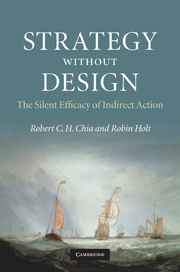Book contents
- Frontmatter
- Contents
- Preface
- Introduction
- 1 Spontaneous order: the roots of strategy emergence
- 2 Economic agency and steps to ecological awareness
- 3 Reconceptualizing agency, self-interest and purposive action
- 4 The ‘practice turn’ in strategy research
- 5 Building and dwelling: two ways of understanding strategy
- 6 Strategy as ‘wayfinding’
- 7 The silent efficacy of indirect action
- Epilogue: Negative capability
- Notes
- Index
Introduction
Published online by Cambridge University Press: 22 January 2010
- Frontmatter
- Contents
- Preface
- Introduction
- 1 Spontaneous order: the roots of strategy emergence
- 2 Economic agency and steps to ecological awareness
- 3 Reconceptualizing agency, self-interest and purposive action
- 4 The ‘practice turn’ in strategy research
- 5 Building and dwelling: two ways of understanding strategy
- 6 Strategy as ‘wayfinding’
- 7 The silent efficacy of indirect action
- Epilogue: Negative capability
- Notes
- Index
Summary
Large streams from little fountains flow,
Tall oaks from little acorns grow.
Old English proverbBoundless – this vast heap earth,
this bottomless heaven,
how perfectly boundless.
T'ao Ch'ien, Elegy for Myself (translated by David Hinton)In this introductory chapter we document several instances of successful accomplishments in a number of business and social spheres and show how we recognize the emergence of a coherent strategy even though the people involved may not have deliberately intended it to be so. This leads us to justify our belief in the plausibility of what we call here ‘strategy without design’, in which invisible coordinating forces appear to work to bring together fruitful outcomes indirectly and circuitously through a plethora of local coping actions. We also show that, conversely, when well-intentioned attempts to deliberately design and engineer a desired strategic outcome dominate concerns they are frequently ineffective and at times may even unexpectedly produce disastrous consequences. Paradoxically, the more direct and deliberate the effort applied the less sustainable the eventual outcome. Conversely, systematic, sustainable, longer-term accomplishments are often a consequence of attending to small, seemingly insignificant details through local, everyday coping actions.
Reaching for the ground
In 1974 the country of Bangladesh experienced a severe famine that threatened the livelihood of thousands in the rural villages. Amidst this chaos and human catastrophe, a Bangladeshi professor at the University of Chittagong was so touched by the plight of the families affected by the famine that he decided to make a small personal loan of US$27 to a group of forty-two local households so that they could begin the process of self-help by producing small items for sale, hence earning much-needed income without the burdens associated with predatory lending.
- Type
- Chapter
- Information
- Strategy without DesignThe Silent Efficacy of Indirect Action, pp. 1 - 24Publisher: Cambridge University PressPrint publication year: 2009



